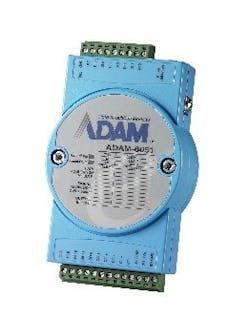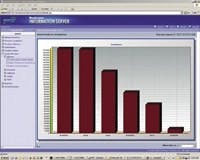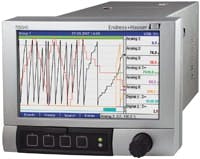Data acquisition systems and recorders tend to be digital and can accept a variety of inputs, says Ravi Jethra, product manager, temperature/data acquisition, at Endress+Hauser, www.us.endress.com. "This tends to vastly broaden the range of applications that can be covered in all types of industrial environments, including factory automation or discrete manufacturing," he explains.
"This leads to usage in all types of industries, including food and beverage, automotive and chemical, just to name a few, for storing data related to monitored parameters on the recorder," says Jethra. "The data being recorded also can be transferred to an ERP system or MES. You could essentially have multiple sensors or transducers hooked up to a recorder monitoring multiple parameters. The recorder comes with an Ethernet connection."
Jethra identifies three viable ways to transfer data from a recorder to an ERP system or MES. They involve transferring the data directly or indirectly in a variety of formats. First, the data from the recorder can be transferred via a gateway device using .xml format. Second, the data can be transferred directly using .csv format. Or, in the third case, the data can be transferred via an OPC server that is hooked up to the recorder.
"Being able to transfer data from a recorder to an ERP system or MES allows for periodic review by upper management or for analyzing productivity or efficiency or inventory management," he says.
"Industries, like commercial electronics, that manufacture high volumes of complex products must understand in real time the quality of the products that ship out the door," explains Santiago Delgado, TestStand product manager at National Instruments (www.ni.com). "These industries log product test information, acquired using data acquisition devices or instrumentation, to ERP systems, so that test and quality engineers can resolve quality issues as quickly as possible."
While not a discrete application, water management systems are an example of how data can be logged and uploaded to an ERP to anticipate peak and trend levels, says Jim McConahay, PE, senior field applications engineer, Moore Industries International (www.miinet.com).
"Using the ERP system, they can strategically anticipate the most economic time of day when electrical pumping costs are lowest and pumping resources are available, even to transfer water from one storage facility to another in anticipation of need," explains McConahay. "The ERP system also provides immediate access to alternative water and pump resources within the system, should an unusual demand or system maintenance be required. While the commodity itself is low-cost on a per-user basis, the overall system is extensive."
Adam-6051 14-channel, isolated digital I/O module provides 12 digital inputs, two digital outputs and two 5 kHz counters with 2,000 Vrms isolation protection. The mixed-function module has a built-in 10/100 Mbps Ethernet port and default or customizable Web page.
Advantech Industrial Automation Group
800/205-7940;
www.advantech.com
NI 9213 module adds high-density thermocouple measurements to the C Series platform to create a modular data acquisition system to collect data from up to 16 independent thermocouples. The module takes up less space than standard instrumentation in a measurement system and provides more channels for measurement with a sampling rate of 75 samples/sec/channel. It can be used in a remote measurement system over an Ethernet or Wi-Fi connection with the NI WLS-9163 wireless C Series single module carrier or as part of an embedded measurement and control system with CompactRIO hardware.
National Instruments
888/280-7645
www.ni.com/dataacquisition
6000 series Paperless Graphic Recorders support EtherNet/IP, supporting up to 200 I/O ports with simultaneous support for Modbus TCP. Standard Ethernet equipment means no unique hardware or software is needed to connect to most major controllers and configuration is made simple with setup wizards and built-in diagnostic tools.
Invensys/Eurotherm
703/443-0000
www.eurotherm.com
DAQManager Data Management Software for DXAdvanced R3 Data Acquisition and Display Station lets users manage and view data via a PC, easily searched for by topics such as date/time, tag name and batch name. Channels recorded on different instruments and intervals can be combined in DAQManager and displayed on the same trend graph. DAQManager adds functions to DXAdvanced R3 including custom graphics, alarm annunciator displays, multi-batch recording and EtherNet/IP and Profibus-DP protocols.
Yokogawa
800/888-6400
www.daqstation.com
IntelliLogger network-enabled, stand-alone data logging, reporting and alarming instruments include Modbus/RTU Master capability to read register values from connected Modbus Slave transducers, power meters, controls and flowmeters. Scanned register values can then be processed, logged to memory, used to trigger alarms and incorporated into FTP, email and Web pages served by the IntelliLogger. Data acquisition from Modbus Slave devices complements hardwired analog and digital signal I/O capability integrated into the HyperWare-II icon-based programming software provided.
Logic Beach
619/698-3300
www.logicbeach.com
DAQ software v. 4.0 is designed to streamline setup and performance of Fluke 2680 Series and NetDAQ networked data-acquisition units. The software enables users to configure input type, alarms, math functions, totalizer function, digital I/O lines, scan speed, interval and trigger type.
Fluke
888/308-5277
www.fluke.com
DATA ACQUISITION SYSTEM
ADRE SXP data acquisition system consists of the 408 Dynamic Signal Processing instrument (DSPi) and ADRE Sxp software for portable asset management programs where speed and flexibility in data collection are needed. It can operate stand-alone in test stands or remotely. It has true client/server architecture, WAN/LAN-enabled, dynamic input cards, an onboard 130 GB hard drive, integrated display, scalability, industry-standard connectors and differential inputs.
GE Energy
775/782-3611
www.ge-energy.com
Equipment Performance Module (EPM) 2.0 tracks and analyzes equipment downtime. It combines ArchestrA architecture with InTouch 10.0 HMI and System Platform 3.0 software to correlate metrics such as downtime or OEE with broader MES functions including formula management, traceability and SPC.
Wonderware
949/727-3200
www.wonderware.com
Memograph M Graphic Data Manager includes up to 20 universal inputs, analyzes the raw data and stores analog values, counter values or quantities and simultaneously up to six different operating times or switch states. Up to 100 alarm setpoint values can be monitored and retransmitted using the six relays included in the basic version. By Modbus or Profibus, the device can be expanded to 40 channels connected to SCADA and PLCs.
Endress+Hauser
888/endress
www.us.endress.com
Trend Historian & Trend Link v. 7.1 collects, stores and manages system process information. It is scalable from a few tags to more than 100,000 tags and can synchronize information to other systems. Time-series data is stored and retrieved in its original resolution and provides continuous background validation of data files to ensure data integrity. The Trend Historian runs on standard PCs as an ActiveX control. This means that it can be embedded in other programs that accept ActiveX controls.
Canary Labs
814/793-3770
www.canarylabs.com

Leaders relevant to this article:











